Article 3: Crows - As Seen in Japanese Prints
(from Author's Collection)
by Thomas A. Crossland
As collectors, each one of us is unique. Over time, we individually develop certain likes and dislikes, and oftentimes then discover that we tend to have an affinity towards certain types of images.
One fellow collector who I know via the Internet seems to collect ONLY images of Mt Fuji. He tells the story of his years earlier lifetime meeting with this magic and most revered of all Japanese landmarks. It was a clear day, the bus views were spectacular, and all was captured wonderfully on a roll of film-or at least he thought so, until this film was later developed and NOT a single photograph came out. The lovingly recorded images of Fuji-san thus remained only etched into his memory. As a result, to this day, he feverishly collects any and all woodblocks of Mt Fuji.
Other collectors find themselves inexplicably drawn to "snow scenes" or "temple scenes." Many it seems are drawn to "bijin-ga" images (prints of beautiful women). For yet others, it's perhaps "seascapes" or "warrior" images.
For me, it's "Crows". Don't know why... can't really explain it. But for some unknown reason I've always liked crows. Perhaps it's their intelligence and cunning. They're known, for example, to gather nuts to then be dropped from high above over roadways knowing that sometimes this impact will crack them open. Similarly, they will also simply "set" nuts into the roadway and wait patiently for cars to then come along and crush open for them.
I also distinctly recall a college text which described a carefully controlled experiment which "proved" crows could "count to 3." This well-conducted experiment involved hungry crows, a cornfield (food), a "shack" next to cornfield, and a group of "hunters" (actually, experimenters). Various numbers of "hunters" would then walk out to field with "shotguns" and enter the "shack"-then a short time later "some" would leave. For example, if "3 hunters walked out" and then "2 hunters were seen to leave," these smart crows KNEW that there was still ONE hunter remaining hidden inside the "shack." Anyway, in various combinations above 4, the crows got confused. But, it was clearly proven that "at least up to 3," the crows could clearly keep score. Pretty cool, or so I thought. Anyway, so I just like crows..
So as a collector of Japanese prints, I've long noted the recurrent theme of "crows" depicted in these woodblocks. It then followed only naturally-and indeed was strongly felt-a need to collect this genre of prints with a passion. What follows below is some of my accumulation of crow prints and images.
I can't really knowingly say if "crows" hold some symbolic meaning or other attraction to the Japanese. My wife, Hisako, simply shrugs her shoulders when asked if crows have any "cultural significance." And nothing I've been able to read or otherwise determine directly indicates a reason or meaning. Perhaps over the years as a culture the Japanese have simply shared the same fascination as I've felt towards these cunning black birds.
"Cawwww!! Cawwww!! Cawwww!!" Enjoy the prints.
TAKAHASHI, Hiroaki (aka, Shotei) "Crows on a Branch" c1920's
AUTHOR's similar effort "Crows on a Branch" 1997
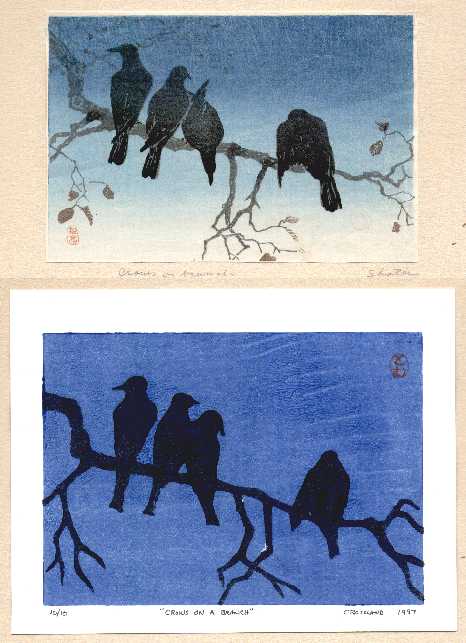
OHARA, Shoson (aka, Koson) "Crow on a Snowy Branch" c1911-15
Unread Artist "Crow" c early 1900's
OHARA, Shoson "Crow and Cherry Blossoms" c early 1900's
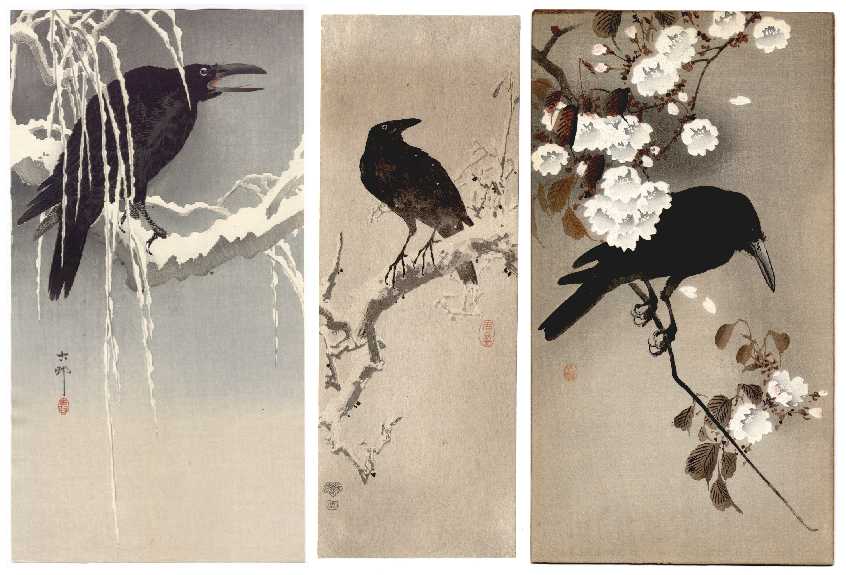
ITO, Sozan "Two Crows Against Moon" c 1910's
YAMAMOTO, Shoun "Two Crows on a Snowy Branch" c 1890-1910
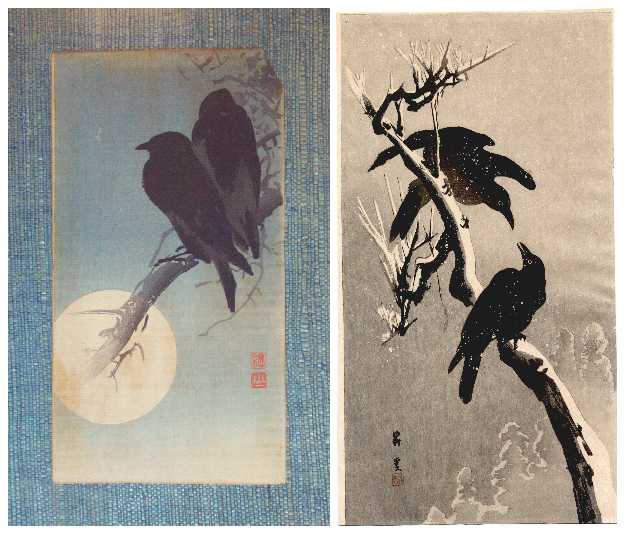
IMAO, Keinen "Crow" (Keinen's Bird & Flower Album) c1891 --
YASUDA, Bairei (aka, KONO) "Crow" (Bairei's Bird & Flower Album) c1883
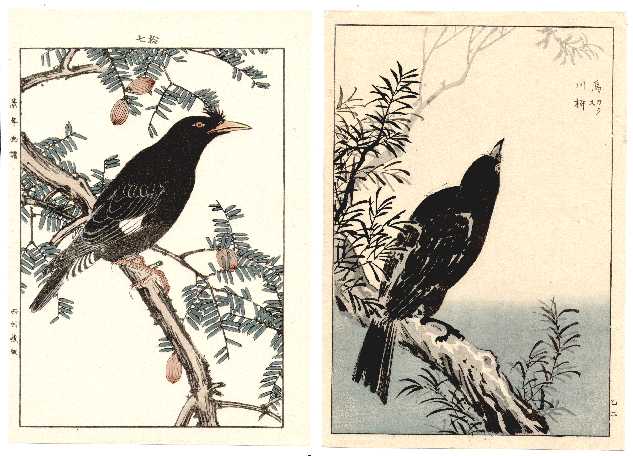
HOKUSAI "Crow, Sword, & Plum Blossom" Surimono org c1822, 1900 restrike
SHIBATA, Zeshin "Crows And Orange Sky" org c late 1800's, 1950 restrike
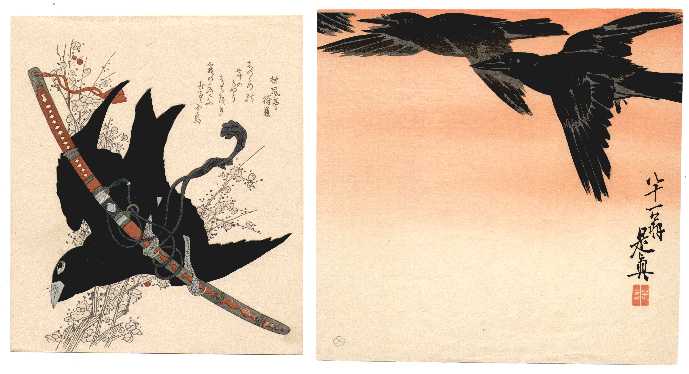
Unread Artist "sumi-e" "Crow" on Scroll, mid-Meiji period c 1870-90
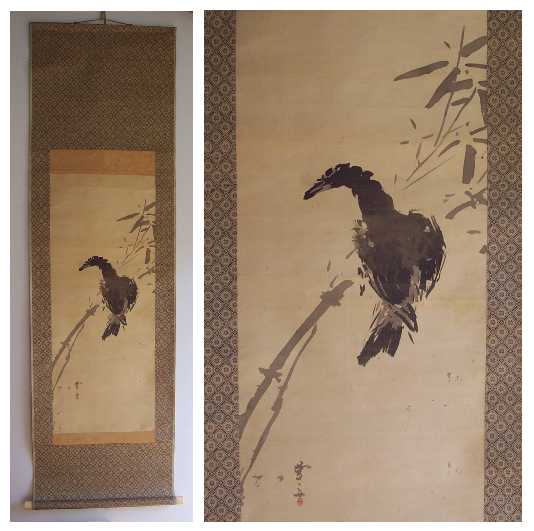
Of course, there exist other genre or sub-sets of images well represented in my "permanent personal collection" of woodblock prints. Also included are "kuchi-e" and "bijin-ga" prints, for example. (These may be topics of future updates.)
As fellow collectors it's quite simple-just allow yourself to instinctively:
"Love and admire that which you collect" and
"collect that which you love and admire."
The text and images of this article are the sole property of its author, Thomas A. Crossland, Copyright 2001; All Rights Reserved.





